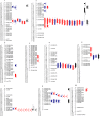Genetic Architecture of Ear Fasciation in Maize (Zea mays) under QTL Scrutiny
- PMID: 25923975
- PMCID: PMC4414412
- DOI: 10.1371/journal.pone.0124543
Genetic Architecture of Ear Fasciation in Maize (Zea mays) under QTL Scrutiny
Abstract
Maize ear fasciation: Knowledge of the genes affecting maize ear inflorescence may lead to better grain yield modeling. Maize ear fasciation, defined as abnormal flattened ears with high kernel row number, is a quantitative trait widely present in Portuguese maize landraces.
Material and methods: Using a segregating population derived from an ear fasciation contrasting cross (consisting of 149 F2:3 families) we established a two location field trial using a complete randomized block design. Correlations and heritabilities for several ear fasciation-related traits and yield were determined. Quantitative Trait Loci (QTL) involved in the inheritance of those traits were identified and candidate genes for these QTL proposed.
Results and discussion: Ear fasciation broad-sense heritability was 0.73. Highly significant correlations were found between ear fasciation and some ear and cob diameters and row number traits. For the 23 yield and ear fasciation-related traits, 65 QTL were identified, out of which 11 were detected in both environments, while for the three principal components, five to six QTL were detected per environment. Detected QTL were distributed across 17 genomic regions and explained individually, 8.7% to 22.4% of the individual traits or principal components phenotypic variance. Several candidate genes for these QTL regions were proposed, such as bearded-ear1, branched silkless1, compact plant1, ramosa2, ramosa3, tasselseed4 and terminal ear1. However, many QTL mapped to regions without known candidate genes, indicating potential chromosomal regions not yet targeted for maize ear traits selection.
Conclusions: Portuguese maize germplasm represents a valuable source of genes or allelic variants for yield improvement and elucidation of the genetic basis of ear fasciation traits. Future studies should focus on fine mapping of the identified genomic regions with the aim of map-based cloning.
Conflict of interest statement
Figures


Similar articles
-
QTL mapping identifies novel major loci for kernel row number-associated ear fasciation, ear prolificacy and tillering in maize (Zea mays L.).Front Plant Sci. 2023 Jan 10;13:1017983. doi: 10.3389/fpls.2022.1017983. eCollection 2022. Front Plant Sci. 2023. PMID: 36704171 Free PMC article.
-
Genetic and QTL analysis of maize tassel and ear inflorescence architecture.Theor Appl Genet. 2006 Feb;112(4):592-606. doi: 10.1007/s00122-005-0133-x. Epub 2006 Jan 5. Theor Appl Genet. 2006. PMID: 16395569
-
Genetic dissection of yield-related traits and mid-parent heterosis for those traits in maize (Zea mays L.).BMC Plant Biol. 2019 Sep 9;19(1):392. doi: 10.1186/s12870-019-2009-2. BMC Plant Biol. 2019. PMID: 31500559 Free PMC article.
-
Hotspot Regions of Quantitative Trait Loci and Candidate Genes for Ear-Related Traits in Maize: A Literature Review.Genes (Basel). 2023 Dec 21;15(1):15. doi: 10.3390/genes15010015. Genes (Basel). 2023. PMID: 38275597 Free PMC article. Review.
-
Review: Recent advances in unraveling the genetic architecture of kernel row number in maize.Plant Sci. 2025 Mar;352:112366. doi: 10.1016/j.plantsci.2024.112366. Epub 2024 Dec 20. Plant Sci. 2025. PMID: 39710150 Review.
Cited by
-
Genetic Diversity and Genome-Wide Association Study of Major Ear Quantitative Traits Using High-Density SNPs in Maize.Front Plant Sci. 2018 Jul 9;9:966. doi: 10.3389/fpls.2018.00966. eCollection 2018. Front Plant Sci. 2018. PMID: 30038634 Free PMC article.
-
Genome-wide association study for kernel composition and flour pasting behavior in wholemeal maize flour.BMC Plant Biol. 2019 Apr 2;19(1):123. doi: 10.1186/s12870-019-1729-7. BMC Plant Biol. 2019. PMID: 30940081 Free PMC article.
-
Genome-Wide Analysis of the MADS-Box Gene Family in Maize: Gene Structure, Evolution, and Relationships.Genes (Basel). 2021 Dec 7;12(12):1956. doi: 10.3390/genes12121956. Genes (Basel). 2021. PMID: 34946905 Free PMC article.
-
Genetic architecture of the maize kernel row number revealed by combining QTL mapping using a high-density genetic map and bulked segregant RNA sequencing.BMC Genomics. 2016 Nov 14;17(1):915. doi: 10.1186/s12864-016-3240-y. BMC Genomics. 2016. PMID: 27842488 Free PMC article.
-
Combining self-organizing maps and biplot analysis to preselect maize phenotypic components based on UAV high-throughput phenotyping platform.Plant Methods. 2019 May 28;15:57. doi: 10.1186/s13007-019-0444-6. eCollection 2019. Plant Methods. 2019. PMID: 31149023 Free PMC article.
References
-
- Bommert P, Lunde C, Nardmann J, Vollbrecht E, Running M, Jackson D, et al. Thick tassel dwarf1 encodes a putative maize ortholog of the Arabidopsis CLAVATA1 leucine-rich repeat receptor-like kinase. Development. 2005; 132: 1235–1245. - PubMed
-
- Emerson RA. Inheritance of certain “abnormalities” in maize. Am Breed Assoc Rept. 1912;8: 385–399.
-
- White OE. Fasciation. Bot Rev. 1948;14: 319–358.
Publication types
MeSH terms
Substances
LinkOut - more resources
Full Text Sources
Other Literature Sources
Miscellaneous

